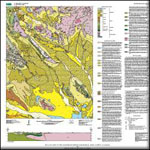The main structural element in the Sulphur Mountain quadrangle is the Elkhorn thrust. This northwest-trending fault is the southernmost structure that bounds the west side of the Late Cretaceous and early Tertiary Front Range basement-rock uplift. The Elkhorn thrust and the Williams Range thrust that occurs in the Dillon area north of the quadrangle bound the west flank of the Williams Range and the Front Range uplift in the South Park area. Kellogg (2004) described widespread, intense fracturing, landsliding, and deep-rooted scarps in the crystalline rocks that comprise the upper plate of the Williams Range thrust. The latter thrust is also demonstrably a low-angle structure upon which the fractured bedrock of the upper plate was translated west above Cretaceous shales. Westward thrusting along the border of the Front Range uplift is probably best developed in that area. By contrast, the Elkhorn in the Sulphur Mountain quadrangle is poorly exposed and occurs in an area of relatively low relief. The thrust also apparently ends in the central part of the quadrangle, dying out into a broad area of open, upright folds with northwest axes in the Sulphur Mountain area.


